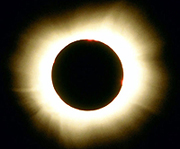 The solar eclipse on January 15 will be seen from the southern tip of the country at Dhanushkodi in Tamil Nadu and neighboring Sri Lanka as the millennium's longest annular solar eclipse will make the sun appear like a 'Ring of Fire' with the moon covering its disc.
The solar eclipse on January 15 will be seen from the southern tip of the country at Dhanushkodi in Tamil Nadu and neighboring Sri Lanka as the millennium's longest annular solar eclipse will make the sun appear like a 'Ring of Fire' with the moon covering its disc.During the eclipse nearly 90 percent of the solar disk will be covered by the moon. Sky watchers will be able to view the eclipse in Sri Lanka from about 11.11 a. m. to 3.12 p. m. while in India the eclipse will start around 11 a. m. and end around 3:15 p. m.
Kanyakumari in Tamil Nadu will be the first place from where the eclipse could be seen, later moving to Rameshwaram and Dhanushkodi and further to Kerala and end in Mizoram in the northeast. More than half ofthe eclipse could be seen from the capital starting at 11.53 a. m. to 15.11 p. m. while people in most part of India will be able to see a partial eclipse.
The annual solar eclipse occurs when the sun and the moon are exactly in line. The moon’s shadow is smaller than the visible disc of the sun. Thus, sun’s rays appear spread out from the outline of the moon making it appear like a Ring of fire.
India witnessed the “Ring of Fire” on Nov 22, 1965 and the next one will not be before June 21, 2020. Duration of 11 minutes 08 seconds makes it the longest annular eclipse of the millennium.
The scientific community and academic institution in the countries where the solar eclipse could be seen are getting into action and involving many younger minds to bring interest on the occurring. Institute of Physics, Sri Lanka has organized a photography contest for the eclipse.
Considering other countries the path of moon's shadow will begin in Africa at 10.44 a. m. and pass through Chad, Central African Republic, the Democratic Republic of the Congo, Uganda, Kenya, and Somalia. The path then crosses the Indian Ocean continuing into Asia through the extreme southern part of India, Bangladesh, Myanmar, and China. Many people around this path region will be able to see a partial eclipse.







0 comments:
Post a Comment